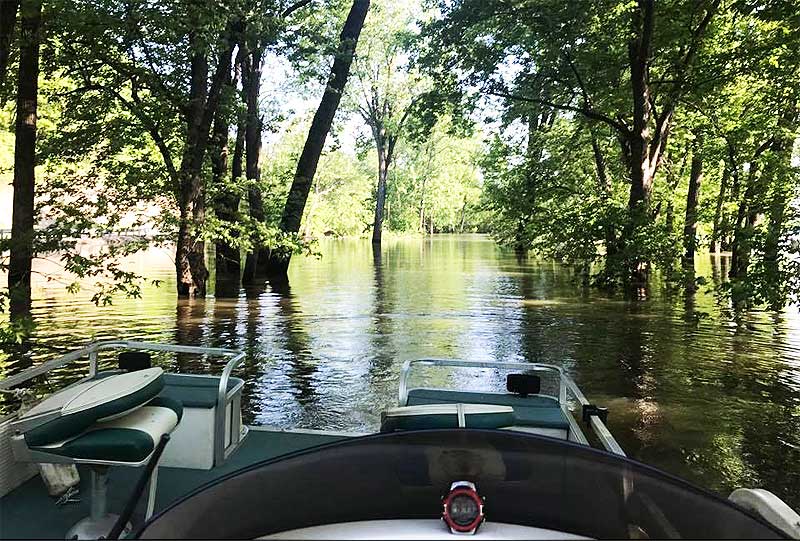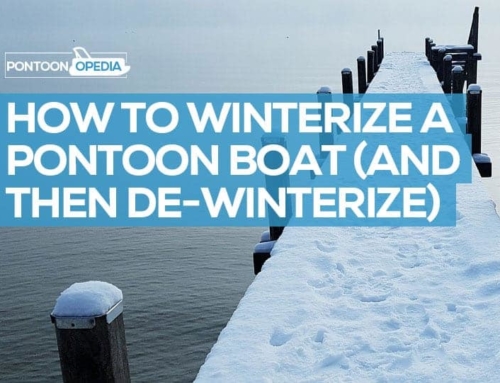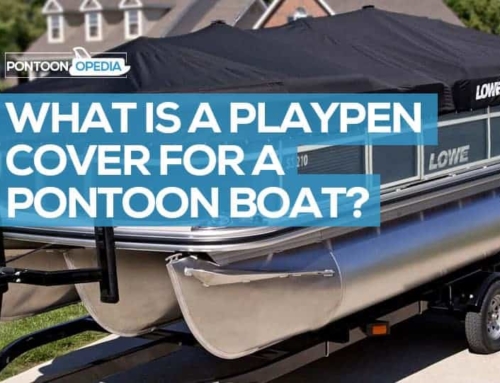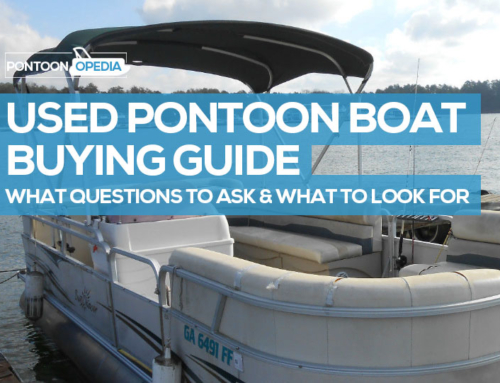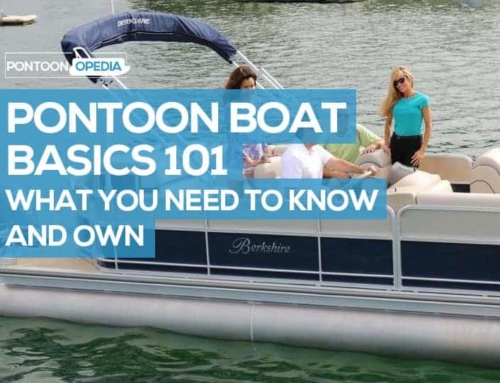Beginners to pontooning will often ask whether it is a good idea to take a pontoon boat out onto a river. The quick and simple answer is yes. But, you will need to adhere to the various safety rules of the waterways plus understand how currents can quickly change and present challenges to how you would normally handle your pontoon.
As you already know, pontoon boats are the most versatile of boats and are hugely popular with those looking to spend the day on the river fishing or just to have some leisure time.
However, it’s important to understand that when traveling on rivers, the environment is very different from lakes. Therefore, you should be properly prepared and plan ahead, especially if you have never done is this type of trip before or are new to pontooning.
Handy Hint: You can read my advice on how to pilot your pontoon boat on a river down the page.
In this article I am going to address a number of key concerns including:
- How to read a river on your pontoon boat
- How to spot hazards on the river
- How to manoeuvre and pilot a pontoon on the river
- How to dock your pontoon boat
But before I get into those technical aspects, let’s start with the fun!
Advantages to Pontoon River Boating
As I already said, the question was asked “are pontoon boats good for rivers” – it’s an resounding yes, and here are some ideas on how you can get the most from your time out on the water.
It could be that you have been boating on a lake for a while now and feel that a river is a next step in venturing further afield with your pontoon. I can certainly relate to that!
When I first had my pontoon boat, I spent the first couple of year just on the lakes, but over time became a little bored with the same old scenery and the crowds at peak season times.
A river offers boaters a lot more freedom and a whole host of destinations; nothing beats the beauty of an endless changing scenery that a river can have.
Things to Know Before Taking a Pontoon on the River
Taking to a river on a pontoon boat tends to offer a different experience each and every time. That’s the nature of rivers, but those differences can be exciting, but also dangerous which is why I always urge new pontooners to ensure they plan and prepare their trip before they hit the water.
Firstly, you need to be aware of the depth of the river you intend to cruise upon. Most pontoon boat owners will know that you need to be mindful of the possibility of rocks, snags, trees, moving sandbars and shallow areas in rivers as these present the biggest threat to your day being ruined (with that in mind, make your that your pontoon boat is insured).
If you are planning on taking to a river that you have never boated on before, then you won’t be aware of the common danger spots to avoid. Talk to other pontooners, do your online research, or even scope out the river on Google Maps first.
Considerations you will need to take include:
- Launching your pontoon – the currents will be different to that of a lake
- Securing your trailer and vehicle – is there a dedicated space to do so?
- How are the currents today – they will change constantly
Above all, if it’s your first time taking your pontoon boat onto a river, start with small steps.
They way in which your pontoon will handle will be different, and this type of experience only comes with practice.
Comparing Pontoon Boat Types for River Use: Key Factors
Selecting the right pontoon boat for river use is crucial for an enjoyable experience. This article compares pontoon boat designs and sizes, emphasizing their suitability for river navigation, to help buyers make an informed decision.
Small vs. Large Pontoon Boats:
Pontoon boat size is significant for river use, as smaller rivers often have shallow waters and narrow channels.
- Small Pontoon Boats: Typically under 20 feet in length, small pontoon boats are ideal for river navigation due to their shallow draft, increased maneuverability, and easy handling in tight spaces. Smaller boats also have lower fuel consumption, making them cost-effective for shorter river trips.
- Large Pontoon Boats: While larger pontoon boats (over 20 feet) offer more space and amenities, they may not be as suitable for river navigation due to deeper draft and reduced maneuverability. However, for wide rivers with ample depth, larger pontoon boats can still be viable.
2-Pontoon vs. 3-Pontoon Models:
The number of pontoons affects river suitability.
- 2-Pontoon Models: Traditional two-pontoon boats have a shallow draft, making them popular for river use. However, they may have reduced stability, especially in rougher water conditions.
- 3-Pontoon Models: Known as tritoon boats, three-pontoon models offer increased stability and better handling in rough waters. While their draft may be slightly deeper, they can still be suitable for river navigation if water depth allows. Tritoons often have better weight distribution, ideal for carrying more passengers or equipment.
- How to Read a River on Your Pontoon Boat
Rivers are always changing and can be far more dangerous than a lake. The environment can be entirely different from one day to the next.
As an example, when mud and sand is scoured from the bottom by floodwaters it will then dump a sandbar further downriver, presently an unexpected hazard that wasn’t there the day before.
You can also encounter trees floating in the river, which can also become snagged either above or below the waterline. All these factors and will mean you need to be able to predict and read how a river behaves when out on your pontoon boat.
As a pontoon river pilot, your core responsibility is to understand that just because you see clear water ahead, it doesn’t mean it can be crossed safely. A depth that could be as shallow as just a few inches, can look just the same at a distance as water with 20 times that.
Be Aware of Currents and Hazards
In all rivers there will be a main current where the largest amount of water flows. During floods, this current will get stronger and in a dry season will decrease. The current can also be less below a control dam when water flow over the spillway is restricted.
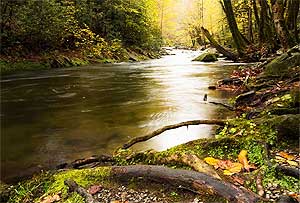
Be aware of snags on the river.
Water is an uncontrollable element that will actively seek out the path of least resistance. In most cases this will tend to be where the water is as its deepest, with flow reducing in shallower waters closer to the river bank.
As I touched on earlier, with changing river currents, sandbars and mud bars will present a hazard. They can appear and disappear without warning, as they build up where the river current has slowed – in most cases they will be found on the inside bend of a river.
Signs that there might be a sandbar hazard in the river can be:
- Subtle differences in how the surface of the water looks
- Changes in the color of the river water
- Seeing a standing wave in just one spot
- Birds can also congregate in the shallow water near a sandbar
How to Pilot a Pontoon on a River Current
Experienced river pontooners will look to estimate how fast the current is by watching the water. Learn how to do this, and you can have consistently safe and enjoyable river trips on your pontoon.
In currents that are under 3 miles per hour you shouldn’t experience any problems; it’s when the water is faster that you need to understand how you should react with your pontoon.
When the current speeds up you will see fixed objects such as buoys starting to develop little wakes of their own – this is the small v-shaped pattern of water that will point upstream from the current.
At speeds of over 6 miles per hour a buoy will start to lean downstream towards the current. As the speed of the water current gets stronger, the wake will get bigger with a more pronounced lean – and in some cases the buoy will disappear under the river water completely.
If you don’t see the buoy, don’t assume that it’s come loose and been sent down river. It could be under the water, where it could present a hazard to your prop. This also applies to other hazards such as snags and deadheads – they could be there, you might not just be able to see them.
Also, in fast-moving river waters, manoeuvring takes on a whole new dimension. It will be harder, with experience and common sense are key to moving your pontoon boat around successfully. Things to be aware of are:
- Currents can change quickly and dramatically
- Strong currents can push your pontoon sideways down river during simple turns
- Whorls and eddies can develop in strong currents
- Buoys and other hazards can become under the waterline
- Sandbars will develop where they weren’t there before
- Be careful on bends due to the natural channel
- Hazards including snags, deadheads, sand boils, wind, waves, and trees
How to Dock a Pontoon Boat in a River Current
Because the river is constantly moving and flowing, your pontoon boat will remain in a constant state of flux until you have tied or anchored it down. You can place the pontoon into neutral, but it will still drift downstream with the current.
This means that docking your pontoon boat on a river can be very different to how you would do it on a lake. Most of time you will need to head into the current in order to dock safely. This is how I advise you do it:
- Ease your throttle back
- Wait until the pontoon is as static as possible
- Turn the wheel towards the pier to bring the pontoon sideways
You can use the same manoeuvring process in reverse if leaving a dock.
Be Aware of the Natural Channel
Lastly, I wanted to talk about the natural channel of the water.
In rivers, it won’t always be in the center as you might expect and will tend to be on the outside of bends.
On river bends, the quicker currents will scour the river bottom on the outside of the bend. Slower moving water will sit on the inside of the bend, and will be dropping sand and silt, which can present a further hazard.
Whilst pontoon boats suit shallow water, you need to be aware of the potential dangers when river boating. If you would rather be in deeper water, then stick to the outside of the bends.
Conclusion
I thoroughly recommend that you take your pontoon boat onto a river. It can open up your scope for pontooning so much more than simply being restricted to a lake, but it is a slightly different discipline and comes with new challenges.
There will be times during the season when the lakes can become overcrowded and, in all honesty, unbearable. If you begin to feel like this, it may be time to start thinking about making that change and heading out to any one of the many rivers and experiencing life aboard a pontoon in a completely different setting and scenario.
But, whilst you might consider yourself to be a skilled pontoon boat pilot, rivers can present huge dangers due to their unpredictability. The risks at play will often far outweigh the desire to get your pontoon boat onto the river for a day’s fishing or leisure, so please be careful and respect the currents.
Above all, plan and prepare.

